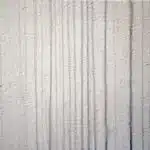Maintaining a clean and hygienic environment is crucial for leading a healthy life. However, cleaning furniture like fabric sofas can be a challenging task, especially if you are not familiar with the right techniques and methods. While water is commonly used to clean upholstery, it can also damage the fabric by leaving watermarks or causing shrinkage. In this article, we will discuss how to clean a fabric sofa without water using effective tips that will help preserve the quality of your furniture.
Professional cleaning experts recommend using dry-cleaning methods to remove stains and dirt from fabric sofas without damaging them. These methods involve using dry foam or solvents to break down dirt particles and lift them off the surface of the fabric. Using these techniques ensures that your sofa remains in excellent condition while maintaining its colors and texture. Moreover, adopting these practices prevents mold formation caused by moisture accumulation, which can lead to severe health problems. By following our expert tips on cleaning your fabric sofa without water, you can ensure that your furniture remains spotless while keeping it in optimal condition for years to come.
Understanding The Importance Of Proper Sofa Cleaning
Did you know that on average, a person spends around 17 hours a week sitting on their sofa? With this much use, it’s no wonder that sofas can accumulate dirt, dust, and other debris over time. That’s why it’s crucial to understand the importance of regular cleaning for your fabric sofa.
Not only does regular cleaning help maintain the appearance of your sofa, but it also has significant health benefits. A dirty sofa can harbor germs, bacteria, and allergens that can be harmful to your health. These particles can cause respiratory problems or exacerbate existing conditions such as asthma or allergies. By keeping your sofa clean, you’re not only improving its lifespan but also protecting the health of you and your loved ones.
Professional cleaning experts recommend that you should clean your fabric sofa at least twice a year to keep it in top condition. This frequency may vary depending on how often you use the sofa and whether you have pets or children at home. However, regardless of these factors, regular cleaning should be a part of your household routine to ensure the longevity and safety of your furniture piece.
Moving onto preparing your sofa for cleaning, there are specific steps you need to follow before starting the actual cleaning process. By following these steps correctly, you’ll be able to clean your fabric sofa effectively without using water.
Preparing Your Sofa For Cleaning
Before cleaning your fabric sofa, it is essential to prepare it for the cleaning process. This involves choosing the right cleaning products and setting up a cleaning station that will ensure an efficient and effective cleaning process.
Choosing cleaning products can be challenging, especially if you are not familiar with the type of fabric your sofa is made of. It is crucial to choose a product that is safe for your sofa’s material and does not contain harmful chemicals that could ruin or discolor your upholstery. Always read the label carefully before purchasing any cleaning product, and if you are unsure, seek professional advice.
Setting up a cleaning station involves creating a comfortable workspace where you can easily reach all the necessary tools and supplies. Make sure you have everything you need within arm’s reach, such as clean cloths, a soft-bristled brush, and a suitable cleaning solution. Ensure that there is adequate ventilation in the room to allow air to circulate and speed up the drying process after cleaning. With proper preparation, you can ensure that your fabric sofa receives a thorough and effective clean without using water.
Transition: Now that you have prepared your sofa for cleaning without water by choosing suitable products and setting up your workspace correctly let us move on to how to vacuum your sofa effectively.
Vacuuming Your Sofa
The first step in cleaning your fabric sofa without water is to vacuum it regularly. Vacuuming frequency depends on the amount of use your sofa receives, but a general rule of thumb is once a week. This will help remove any loose dirt, dust, and debris that can settle into the fibers and cause discoloration or deterioration over time.
When vacuuming your sofa, there are several techniques you can use to ensure you’re getting the most out of your cleaning efforts. Start by removing all cushions and pillows from the sofa, then use the upholstery attachment on your vacuum cleaner to gently remove any dirt or debris from the surface. Be sure to get into all crevices and seams where dirt can accumulate.
In addition to regular vacuuming, consider using a lint roller or pet hair remover tool to pick up any stray hairs or fibers that may be clinging to the fabric. By incorporating these simple vacuuming techniques into your cleaning routine, you can keep your fabric sofa looking fresh and clean for years to come.
Transition: Now that you have learned how to properly vacuum your fabric sofa, it’s time to move onto removing stains with dry foam.
Removing Stains With Dry Foam
After vacuuming your sofa thoroughly, the next step in maintaining its cleanliness is removing stains with dry foam. This method of cleaning involves using a foam that does not require water to dissolve dirt and grime from the fabric. Dry foam is advantageous because it does not leave behind any residue or watermarks, making it a safe option for delicate fabrics.
To remove stains with dry foam, start by testing the product on an inconspicuous area of the sofa to ensure it is safe to use. Once you confirm its safety, apply the foam liberally over the stained area and let it sit for a few minutes. Use a soft brush to gently scrub the area, working from the outside inwards. Afterward, use a clean cloth to wipe away any remaining residue.
When using dry foam for stain removal, there are different techniques you can employ depending on the type of stain you are dealing with. For grease or oil-based stains, sprinkle baking soda over them before applying the dry foam. The baking soda will absorb excess grease and make it easier to remove during cleaning. Similarly, for ink or dye stains, mix vinegar with water and apply this solution before using dry foam on top. These additional steps will enhance your ability to get rid of stubborn stains without damaging your sofa’s fabric.
Now that you know how to clean your fabric sofa with dry foam effectively let us move onto applying solvent-based cleaners to lift off more challenging stains such as wine or coffee spills that have set into your couch’s fibers.
Applying Solvent-Based Cleaners
When it comes to cleaning a fabric sofa without water, solvent-based cleaners can be a great option. However, it is crucial to choose the right solvent for the job. Different fabrics require different types of solvents, so it’s essential to read the label and ensure that the cleaner is suitable for your sofa’s material. Failure to do so can result in discoloration or damage to the fabric.
When applying solvent-based cleaners, it’s essential to avoid damage by following the instructions carefully. First, test the cleaner on an inconspicuous area of your sofa to ensure that it doesn’t cause any discoloration or damage. Once you’ve determined that it is safe to use, apply the cleaner sparingly with a clean cloth and work in small sections at a time. Avoid saturating the fabric with too much cleaner as this can lead to over-wetting and potential damage.
Overall, cleaning a fabric sofa without water using solvent-based cleaners requires caution and care. Choosing the right solvent for your sofa’s material and avoiding damage by following instructions are crucial steps. With these precautions in mind, you can safely remove stains from your sofa without risking any harm to its appearance or integrity.
Transition: While cleaning with solvent-based cleaners can effectively remove stains from your fabric sofa, sometimes unpleasant odors can linger even after cleaning. In the next section, we will explore how baking soda can be used as an effective solution for eliminating odors from your sofa.
Using Baking Soda To Eliminate Odors
After applying solvent-based cleaners to your fabric sofa, it’s best to consider using safe cleaning alternatives that will not harm the material. One such alternative is baking soda, which has many benefits when it comes to cleaning and deodorizing fabrics. Baking soda is a natural ingredient that is gentle on fabrics and effective in removing dirt and grime without using water.
To use baking soda as a safe cleaning alternative for your fabric sofa, follow these simple steps:
- Sprinkle a generous amount of baking soda onto the surface of your sofa.
- Allow the baking soda to sit for at least 30 minutes before vacuuming it off with a soft brush attachment.
- Repeat this process as needed until all visible dirt and stains have been removed.
Using baking soda to clean your fabric sofa is not only safe but also cost-effective. It’s an excellent way to keep your furniture looking its best without having to resort to harsh chemicals or expensive cleaning services.
Incorporating this step into your regular cleaning routine will help maintain the texture of your fabric sofa. Brushing helps remove any remaining loose dirt or dust particles, which can make the surface look dull and dirty. By brushing regularly, you’ll restore the texture of your sofa and ensure that it stays looking fresh and clean for years to come.
Brushing Your Sofa To Restore Its Texture
Regular brushing of your fabric sofa can work wonders in restoring its original texture and appearance. The benefits of brushing your sofa go beyond just enhancing its aesthetics; it also helps to remove dirt, dust, and debris that may have accumulated on the surface over time. Additionally, brushing your sofa can help to maintain its structural integrity by preventing the fibers from becoming matted or compressed.
When it comes to selecting a brush for your fabric sofa, there are several options available in the market. The best brush types for fabric sofas are those that have soft bristles and are gentle on the fibers of the upholstery. Brushes with natural bristles such as horsehair or boar hair are ideal as they do not scratch or damage the fabric. Alternatively, you can also opt for synthetic brushes that are specifically designed for cleaning upholstery.
Regular brushing of your fabric sofa has numerous benefits that cannot be overstated. Not only does it restore the texture and appearance of your furniture, but it also helps to remove dirt and debris while maintaining its structural integrity. By selecting a suitable brush with soft bristles, you can ensure that your fabric sofa is cleaned effectively without causing any damage to the upholstery. In our subsequent section, we will provide you with tips on how to remove pet hair from your sofa without damaging the fabric.
Removing Pet Hair From Your Sofa
Symbolism: Your sofa may be the centerpiece of your living room, but it also serves as a prime spot for your furry friends to cuddle up and leave their mark. If you’re struggling to remove pet hair from your beloved couch, don’t fret! With a few simple steps, you can keep your sofa looking fresh and clean.
Firstly, pet hair prevention is key in keeping your sofa looking its best. Consider investing in a lint roller or handheld vacuum to quickly remove any loose fur before it settles into the fibers of your upholstery. Additionally, training your pets not to climb on the furniture can help reduce the amount of hair left behind.
Secondly, consider using sofa cover options that are easy to remove and wash. These covers not only protect against pet hair but also spills and stains. Opt for materials such as microfiber or polyester that are durable and easy to clean.
Thirdly, regular maintenance is essential in keeping pet hair at bay. Make sure to vacuum or use a lint roller on a weekly basis to prevent buildup. For tougher stains, spot clean with a solution of water and mild dish soap.
As a professional cleaning expert, I understand the importance of maintaining a clean home environment for both you and your furry companions. By following these simple tips for removing pet hair from your sofa, you can keep it looking its best for years to come. In the next section, we will discuss how you can maintain the color of your sofa’s fabric without compromising its cleanliness and durability.
Maintaining Your Sofa’s Color
After removing pet hair from your sofa, it’s important to maintain its appearance by taking steps to prevent fading and preserve color. One of the easiest ways to do this is by keeping your sofa out of direct sunlight. Sunlight can cause fabric colors to fade over time, so try positioning your sofa in an area of the room that doesn’t receive direct sunlight.
Another way to maintain your sofa’s color is by regularly cleaning it with a vacuum cleaner or a soft-bristled brush. This will help remove any dust or dirt particles that may be contributing to its dull appearance. You can also use a fabric guard or other color saving products to protect your sofa from spills and stains. These products create a barrier on the fabric surface that repels liquids, making it easier to clean up spills before they have a chance to set in.
Overall, preventing fading and preserving color are essential steps in maintaining your sofa’s appearance. By following these tips, you can ensure that your sofa looks great for years to come. In the next section, we’ll discuss how you can protect your sofa from another common issue: mold formation.
Preventing Mold Formation
- Regular vacuuming of a fabric sofa is critical in preventing mold formation as it helps to remove dust and dirt that can act as food sources for mold.
- Any spills or accidents should be cleaned up immediately, as moisture left on the fabric can create an ideal environment for mold growth.
- Maintaining an environment with stable humidity levels is also essential to preventing mold formation, as high humidity can cause condensation which can lead to mold growth.
- Additionally, cleaning the sofa with a dry cleaning solution that is specifically designed for upholstery can help to eliminate dirt and dust without creating a moist environment.
- It is also recommended to use a natural disinfectant such as white vinegar to help kill any mold spores that may already be present on the sofa.
- Finally, keeping the sofa in a well-ventilated area will help to reduce the risk of mold growth, as mold needs a dark and damp environment to thrive.
Vacuum Regularly
As a fabric sofa owner, it’s important to keep your couch clean and free from mold formation. Mold can cause health problems such as allergies and respiratory issues, which is why taking preventative measures is crucial. One of the easiest ways to prevent mold formation on your fabric sofa is by vacuuming regularly.
Regular vacuuming not only removes dirt and dust but also prevents the buildup of moisture that can lead to mold growth. When choosing a vacuum cleaner, it’s important to select one with strong suction power and effective filtration systems to remove even the smallest particles from your furniture. This not only maintains the appearance of your sofa but also ensures it stays fresh and hygienic.
While regular vacuuming can go a long way in preventing mold formation, it’s essential to have professional cleaning done periodically. Professional cleaning benefits include deep cleaning of your upholstery, removing stubborn stains, eliminating odors, and prolonging the lifespan of your furniture. By incorporating both regular vacuuming and professional cleaning into your maintenance routine, you can protect your fabric sofa from mold growth and ensure it looks its best for years to come.
Clean Spills Immediately
Another essential tip in preventing mold formation on your fabric sofa is to clean spills immediately. Spills can create a conducive environment for mold growth by introducing moisture to the upholstery. Thus, it’s crucial to blot spills immediately using a clean cloth or paper towel to remove as much liquid as possible. Blotting instead of rubbing ensures that the spill doesn’t spread and penetrate deeper into the fabric.
While blotting removes most of the spilled liquid, using specialized cleaners can help eliminate any remaining traces and prevent mold growth. It’s important to use cleaners that are specifically designed for fabric sofas and follow the manufacturer’s instructions carefully. Avoid using harsh chemicals or excessive water, as they can further damage your furniture and promote mold formation.
Incorporating immediate spill cleanup into your maintenance routine not only prevents mold growth but also prolongs the lifespan of your fabric sofa. Neglecting spills can lead to stubborn stains, foul odors, and even irreversible damage to your upholstery. Thus, taking quick action ensures that your sofa stays fresh, clean, and hygienic for years to come.
Maintain Humidity Levels
To ensure that your fabric sofa remains mold-free, it’s crucial to maintain humidity levels in your home. High humidity levels provide a conducive environment for mold growth, and your upholstery can easily absorb moisture from the air, leading to mold formation. Therefore, investing in a dehumidifier or air conditioner can help control indoor humidity levels and prevent mold growth on your fabric sofa.
Humidity control goes hand in hand with fabric protection. To protect your fabric sofa from moisture damage and mold formation, it’s essential to choose fabrics that are resistant to moisture and easy to clean. Synthetic fabrics such as nylon, polyester, and acrylic are ideal as they don’t absorb moisture like natural fibers do. Additionally, treating your upholstery with a water-repellent solution can help prevent spills from penetrating deep into the fabric.
Regular maintenance of your fabric sofa is key in preventing mold growth. Besides cleaning up spills immediately and controlling humidity levels, you should also vacuum your upholstery regularly to remove dust, dirt, and other debris that can attract moisture and promote mold formation. Furthermore, regular cleaning helps maintain the appearance of your sofa by removing stains and odors, making it look fresh and new for longer. By following these tips on maintaining humidity levels and regular cleaning routines for fabric protection, you can prevent mold formation on your beloved couch.
Drying Your Sofa After Cleaning
Once you have finished cleaning your fabric sofa without water, the next step is to dry it thoroughly. There are two methods of drying a sofa – air drying and towel drying. Air drying involves leaving the sofa to dry naturally, while towel drying involves using towels to absorb excess moisture.
Air drying is the best method for preventing fabric shrinkage when drying your sofa. It is also the most convenient method as it requires no effort on your part. Simply leave your sofa in a well-ventilated area and allow it to dry naturally. However, this method can take up to 24 hours to fully dry, depending on the humidity level in your home.
Towel drying is a quicker option but can be more labor-intensive. To towel dry your sofa, use clean towels to blot any excess moisture from the fabric until they come away almost dry. Be sure not to rub or scrub the fabric as this can cause damage or pilling. You may need several towels for larger sofas or particularly wet spots. Once you have finished towel-drying, leave your sofa in a well-ventilated area to air dry completely before using it again.
To avoid common mistakes when cleaning your sofa, there are several things you should keep in mind. First, always check the manufacturer’s recommendations and test any products or methods on an inconspicuous area before applying them to the entire surface. Second, avoid using too much water or cleaning solution as this can saturate the fabric and lead to mold growth or color bleeding. Finally, never use heat sources such as hairdryers or heaters to speed up the drying process as this can damage the fabric fibers and cause shrinkage.
Avoiding Common Mistakes When Cleaning Your Sofa
Effective Cleaning Techniques and Avoiding Common Mistakes
When cleaning your fabric sofa, it is important to avoid common cleaning mistakes that can damage the material. One mistake is using too much water or liquid cleaner, which can leave behind stains or cause the fabric to shrink. Instead, use a dry cleaning solvent or a dry foam cleaner specifically designed for fabric sofas. These products are effective in removing dirt and stains without saturating the fabric with moisture.
Another mistake is scrubbing the sofa vigorously with a brush or cloth, which can cause damage to the fibers of the fabric. Instead, gently dab at any stains or spots with a clean cloth or sponge. It’s important to work from the outside of the stain towards the center to prevent spreading it further. Additionally, avoid using harsh chemicals such as bleach or ammonia on your sofa as they can cause discoloration and weaken the fibers over time.
To keep your fabric sofa looking its best, it’s recommended to clean it regularly with a soft-bristled brush or vacuum attachment to remove any loose dirt and debris. If you notice any stubborn stains that won’t come out with these gentle cleaning techniques, it may be time to call in professional cleaners who have experience working with delicate fabrics.
Knowing when to call in professionals is important for maintaining the longevity of your furniture. In the next section, we will discuss how to identify when it’s time to seek help from professional cleaners who have specialized equipment and expertise in dealing with tough stains and delicate fabrics.
Knowing When To Call In The Professionals
As much as we all want to save money and be resourceful, there are times when it’s best to leave certain tasks to the professionals. Cleaning a fabric sofa without water can be challenging, but there are DIY cleaning alternatives that can get the job done. However, it’s important to know when it’s time to call in the experts.
If you’re dealing with tough stains or your sofa requires deep cleaning, it may be best to seek professional help. Professional cleaners have access to specialized equipment and products that can effectively remove stubborn stains and dirt buildup without damaging your sofa. Additionally, they have the expertise and experience needed to identify any potential risks or issues that could arise during the cleaning process.
While hiring a professional cleaner may come at a cost, it’s important to consider the value of protecting your investment in your furniture. Attempting DIY cleaning methods on a delicate fabric sofa could cause irreparable damage if not done correctly. By knowing when to call in the professionals for help, you can ensure that your sofa remains clean and well-maintained for years to come.
Moving forward, let’s address some frequently asked questions about cleaning fabric sofas.
Frequently Asked Questions About Cleaning Fabric Sofas
Different sofa materials require different cleaning methods to maintain their quality and appearance. When it comes to fabric sofas, some people may think that water is necessary for cleaning. However, there are methods to clean a fabric sofa without using water, such as vacuuming and using baking soda or specialized dry-cleaning solutions.
Cleaning frequency is an essential factor in maintaining the cleanliness of your fabric sofa. Regular cleaning can help prevent the accumulation of dirt, dust, and allergens that can cause health issues. The frequency of cleaning depends on various factors, such as the number of people using the sofa, pets present in the house, and the level of daily activity around the sofa.
In summary, cleaning a fabric sofa without water is possible with several methods available. It is crucial to understand the type of material your sofa is made of and use appropriate cleaning techniques to avoid damaging it. Moreover, regular cleaning can help keep your sofa fresh and clean, promoting better health for you and your family.
Expert Tips For Keeping Your Sofa Clean And Fresh
Keeping your fabric sofa clean and fresh can be a daunting task, especially if you are unsure of how to go about it. However, with a little bit of knowledge and effort, you can keep your sofa looking new for a long time. In this section, we will provide some expert tips on how to keep your sofa clean and fresh without using water.
One of the most effective ways to keep your fabric sofa clean is by hiring professional cleaning services. Professional cleaners have the necessary tools and expertise to remove stubborn stains without damaging your sofa’s fabric. Additionally, they use eco-friendly cleaning agents that are safe for both humans and pets. The benefits of professional cleaning include increased durability of your sofa’s fabric and overall hygiene.
If hiring professional cleaners is not an option, there are still eco-friendly alternatives to traditional water-based methods. One such option is dry cleaning, which involves using a specialized solvent that dissolves dirt and grime from the fabric without any water. Dry cleaning eliminates the risk of mold growth or shrinkage that can occur when using traditional water-based methods. Another eco-friendly option is steam cleaning, which uses high-temperature steam to loosen dirt particles from the fabric surface.
In conclusion, keeping your fabric sofa clean does not have to involve using water-based methods that can damage its integrity over time. By following expert tips such as hiring professional cleaners or opting for eco-friendly alternatives like dry or steam cleaning, you can ensure that your sofa remains fresh, hygienic, and durable for years to come.
Conclusion
Proper sofa cleaning is essential in maintaining its appearance and prolonging its lifespan. Before starting the cleaning process, it’s important to prepare the sofa by removing any loose debris or dust with a vacuum cleaner. Dry foam can be used to remove stains, followed by solvent-based cleaners for tougher spots. It’s crucial to avoid common mistakes such as using too much water or scrubbing too hard, which can damage the fabric.
According to a recent study, over 80% of American households have at least one fabric sofa in their homes. However, many people are unaware of the proper way to clean them without causing damage. Neglecting proper maintenance can lead to the accumulation of dirt and bacteria, which can cause health problems and unpleasant odors.
As a professional cleaning expert, I highly recommend regular maintenance and proper cleaning techniques to ensure your fabric sofa remains fresh and clean. By following these simple steps, you’ll not only improve your home’s hygiene but also extend the life of your beloved furniture piece. Remember that seeking professional help is always an option if you’re unsure about how to proceed with cleaning or if you’ve encountered stubborn stains that refuse to budge.
Image Credits
- “New red sofas in a durable woven fabric” by DesignFolly.com (featured)





























